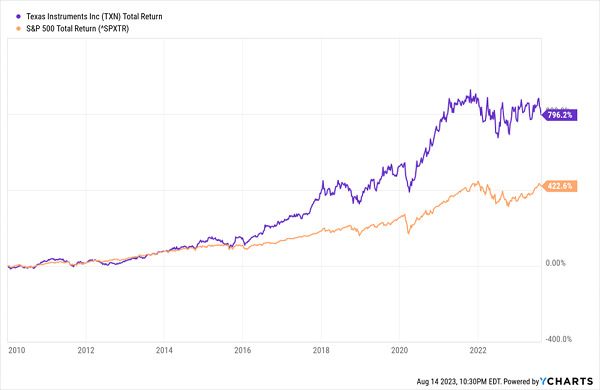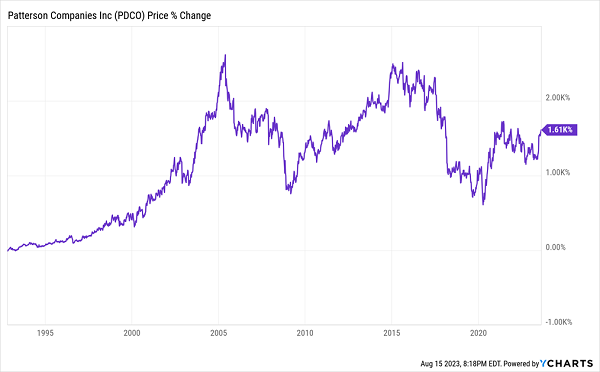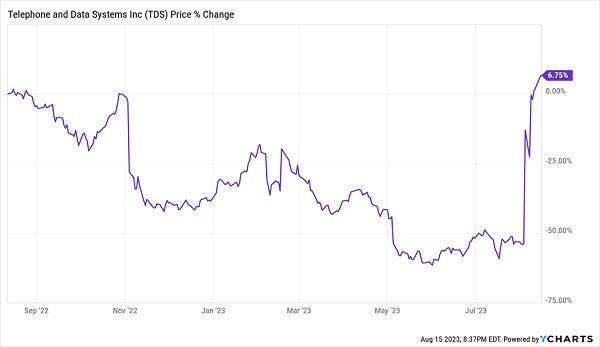As contrarian investors, we have no desire to buy the stock market while it’s hot. We wait for it to cool off. And cooling off it is.
Three weeks ago, I warned that NVIDIA Corp (NVDA) was pricey. On cue, the stock sank 10%!
It’s since bounced, but I’m not sure the bottom is in for this bubbly darling. More tears are likely.
So what to buy instead? I’m intrigued by stocks that have the ability to soar while the broader market sinks. That’s a strategy we employed previously with semiconductor maker Texas Instruments (TXN).
Below is a chart of TXN’s performance over the last decade. You can see that the stock more or less tracked the market for half of that time before setting up and then sprinting past the benchmark in early 2016.
TXN Plants Its Flag

With the pattern firmly established, I recommended TXN in my Hidden Yields service in June 2017. The result? The stock handed us a 140% total return in about four-and-a-half years—that’s 43 percentage points better than the S&P 500’s 97% return during the same time period!
Today, we’re looking for similar relative strength. Stocks that go up regardless of action in the broader market! Here are three that are suspiciously strong in the face of seriously headwinds.
Phillips 66 (PSX)
Dividend Yield: 3.7%
Phillips 66’s (PSX) recent run to 52-week highs says less about the velocity of the move and more about what PSX shares have been doing over the past year. Phillips has spent most of 2023 in a holding pattern, but a recent burst has it trying to escape its range.
Is Phillips 66 Breaking Out, Or Faking Us Out?

In 2012, ConocoPhillips (COP) spun off its midstream and downstream operations in the form of Phillips 66 (PSX). A year later, Phillips 66 pulled off its own spinoff, unloading its pipelines, terminals and other assets into Phillips 66 Partners LP (PSXP).
What remains is a refining business whose 13 facilities can process 1.9 million barrels of crude oil daily; a marketing segment selling fuel products via roughly 8,900 locations worldwide under the Phillips 66, Conoco and 76 brands; midstream operations including PSXP as well as a 50% interest in DCP Midstream LLC and 16% stake in Novonix; and chemicals operations thanks to a 50% joint venture interest in Chevron Phillips Chemical Company (CPChem).
Phillips 66 is riding high amid several positive catalysts, including a stellar second-quarter earnings report that saw profits handily beat expectations. It was also reported earlier this month that PSX and Archer Daniels Midland (ADM) are discussing forming a biofuels joint venture that would help produce lower-carbon jet fuel.
It’s worth noting that PSX has also risen alongside crude oil prices. Refineries purchase oil from producers and turn it into gasoline, diesel fuel, heating oil and other end products. In theory, higher crude prices could hurt margins—if demand doesn’t keep up. On the one hand, there’s increasing chatter about a “soft landing” has traders more optimistic that demand will, in fact, keep up. However, refiners have to deal with notoriously seasonal trends that can weigh heavily on margins, so these can be quite cyclical plays.
One reason to like Phillips compared to its peers, however, is all of the non-refining businesses I mentioned above. This relatively high product-line diversity keeps PSX from being overexposed to that refining-margin volatility. That makes me more confident in Phillips continuing its dividend growth, which picked up in 2021 after a COVID-prompted pause.
Patterson Companies (PDCO)
Dividend Yield: 3.1%
Patterson Companies (PDCO) is an oddball of a healthcare company that’s effectively split into two main arms: animal health and (human) oral health.
Patterson Animal Health, which makes up a little more than 60% of revenues, is a full-line distributor of health products, equipment, software and technology to veterinarians in the U.S. and abroad. The vast majority of sales are consumables—everything from pharmaceutical products to grooming supplies to ID tags—and it even has its own house brands.
Patterson Dental, which makes up the remaining 40% or so of sales, is a bit more diversified, with 56% of sales coming from consumables, 32% from equipment and software, and the remaining 12% coming from value-added services and other offerings. Like, with Animal Health, Dental is focused not on consumers, but healthcare providers—in this case, dental offices. Products range from orthodontics to handpieces to crowns and bridges.
PDCO is a long way away from resetting highs last seen in 2005 and 2015, but it’s attempting to break out of a range that it’s been mired in for roughly two years.
Is Patterson’s Latest Rally All Bark, Or Does It Have Some Bite?

Investors have bought with both hands since June, when Patterson reported a great end to its fiscal 2023. Q4 earnings per share (EPS) jumped 14% year-over-year, internal sales improved by 6%, and its 2024 earnings guidance topped analyst expectations, suggesting core growth in the middle single-digits.
There’s plenty to like here: Dental and animal health aren’t completely recession-proof, but they’re at least somewhat resilient. And PDCO’s actual business is increasingly efficient—its 6.7% operating margin is among its highest in five years. And the stock is fairly valued at worst across a host of metrics.
Patterson does have a history of fairly volatile profitability and stock swings, however—I’d like to see more of the same for a while before I’m confident PDCO is truly on the right track. Also nagging me is a dividend that has been stagnant since 2017 despite a perfectly manageable payout ratio, which currently sits around 50%.
Telephone and Data Systems (TDS)
Dividend Yield: 4.1%
Telephone and Data Systems (TDS) is as strange a chart as you’ll find. The stock is up 73% in 2023, has more than doubled over the past month and is at fresh 52-week highs—and yet is up just 7% over the past year.
What Do We Have Here?

Telephone and Data Systems is a telecom company that provides wireless cable, broadband, TV, and other products and services to roughly 6 million customers nationwide across several brands, including TDS, OneNeck and UScellular.
That last brand is the reason for TDS’s recent share-price explosion.
TDS actually holds an 83% stake in UScellular parent United States Cellular (USM). And in early August, TDS and USM announced that they were considering “strategic alternatives for UScellular.”
For those not in the know, “strategic alternatives” is Wall Street for “looking for the exits.” Outcomes sometimes include spinoffs and IPOs, though in this case, the most likely alternative would almost have to be a sale of the company. For now, TDS has retained Citi as its financial advisor, though no deadline or timetable has been set for the strategic review.
This would be an intriguing opportunity if TDS were actually growing—but the fact that the stock has more than doubled (and thus halved the yield, too) on news that it will be significantly shrinking the business leads me to believe that the easy money has quickly come and gone—and that this likely isn’t the start of a larger comeback trail.
Adding to the uncertainty is the potential for a legal-driven shot to TDS’s cash pile. TDS in July reported that it had some 10 miles of lead-covered cables—a response to a blockbuster Wall Street Journal report on toxic lead cables criss-crossing the nation. While larger telecoms AT&T (T) and Verizon (VZ) are facing far more scrutiny, TDS might eventually face legal consequences or fines—and at the very least, it’s on the hook for addressing (read: replacing) these cables.
It’s Not Too Late: Lock In the “Recession-Resistant Portfolio” Now!
All three of these stocks might be in the clouds right now, but with perhaps the exception of Patterson (and even then, to a limited extent), there’s not much recession-resistance to be found.
Like I said earlier: I don’t sweat economic pullbacks because I focus on recession-resistant stocks. New highs and relative strength can sometimes signal this virtue—but not always.
No, for now, I’m sticking with a small, overlooked basket of recession-resistant stocks that haven’t just been surviving over the past couple years of market tumult—they’ve been thriving.
In fact, they look like they could be the market’s best protective plays for the recession to come, regardless of whether it hits in 2023 or 2024.
To the uninformed investor, these stocks will seem downright boring. In fact, I’m betting that you haven’t heard of any of these—after all, the mainstream media rarely covers some of them, and it outright ignores others.
But selecting companies with a proven track of increasing their dividend payments is the safest, most reliable way to get rich in the stock market. And I want to show you how it’s done. Click here to get a copy of my 5 Recession-Resistant Dividend Stocks With 100% Upside report, including full analyses of each pick … and I’ll throw in a few other bonuses, too!
